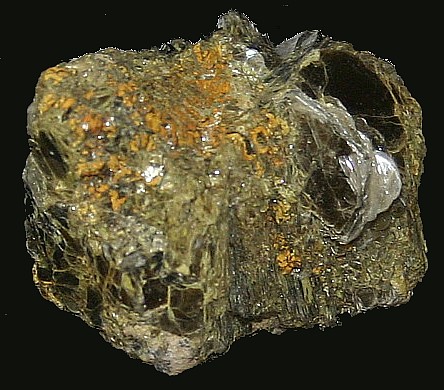|
.
Uraninite
Mineral Facts:
Chemical
Formula: UO2
Most
specimens also contain small amounts of lead, thorium, yttrium, cerium,
nitrogen, helium, argon, and radium It contains so many different components
that a perfect formula is almost impossible to grasp. Also known as
pitchblende.
Colors:
Dark gray,
brown or black and opaque.
Hardness:
5.5
Density:
9 to 9.7
Cleavage:
Indistinct.
Crystallography: Isometric
Crystallizes in
octahedrons, but well developed crystals are rare, with the material usually
occurring in crystalline masses and botyroidal groups.
Luster:.
Sub-metallic luster to pitch like, dull.
|
 |
|
Composition, Structure and
Associated Minerals:
The chief
interest in the mineral lies in the fact that
uraninite or pitchblende
is one of the
principal sources of uranium. Uraninite occurs either as a primary
constituent of granite rocks or as a secondary mineral with ores of
silver,
lead, copper, etc. An uncertain combination of the oxides of uranium, U03
and U02 . With small amounts of lead and the rare elements, thorium,
yttrium, cerium, nitrogen, helium, argon, radium. Like the other uranium
minerals it is radioactive. It is the mineral in which the gas helium was
first discovered on the earth, having been previously noted in the gases
surrounding the sun by means of the sun's spectrum. In urainite, also was
first discovered the rare and strange substance, radium. Pitchblende is
possibly an amorphous uraninite containing a very little thoria and much
water. Its specific gravity is often as low as 6.5, due probably to partial
alteration and excess water.
Identification
and Diagnostics
Before the blowpipe uraninite is infusible.
Some specimens color the flame green with copper. With borax it gives a
yellow bead in the
oxidizing flame, turning green in the reducing flame. All specimens give
reactions for lead and many for
sulphur
and arsenic. The mineral is
soluble in nitric and sulphuric acids, with slight evolutions of helium, the
ease of solubility increasing with the increase in the proportion of
rare earths present. Uraninite is distinguished from wolframite, samarskite,
columbite and tantalite, by lack of cleavage, greater specific gravity, and
differences in crystallization. From all but samarskite it is also
distinguished by the reactions for uranium and, in the case of most
specimens, by the reaction for lead. It is especially characterized by its
pitch-black luster.
Occurrence,
Localities and Origins:
Uraninite is a major ore of of the metal
uranium. Some of the highest grade uranium ores in the world are
concentrations of uraninite or pitchblende. Uraninite occurs in pegmatites
and in veins associated with silver, lead, copper and other ores. It is
found in the ore veins of
Schneeberg in
Saxony,
in connection with the tin deposits of Cornwall, England, and at
Joachimsthal, Austria,
and
Rezbdnya in Hungary.
It has been found in pegmatites near Moss, Arendal and other points in
Norway. Large amounts of pitchblende have been mined at the
Shinkolobwe mine in the Democratic Republic of the Congo and in the
Athabasca Basin in northern Saskatchewan, Canada. Another important location
where pitchblende has been mined is at Great Bear Lake in the Northwest
Territories of Canada, where it is found in large quantities associated with
silver.
Uraninite also occurs in Australia, and South Africa.
In the United States it occurs in pegmatites at
Glastonbury,
Middletown and Branchville, in Connecticut; at the Mitchell County mica
mines,
North Carolina; and at Barringer Hill, Llano County, Texas. It is also
has been mined
in large quantity near Central City, Gilpin County, Colorado, where it
occurs in a narrow vein
associated with
gold,
galena
tetrahedrite,
chalcopyrite and other ore minerals.
It has been found in the mica mines of Mitchell County, North Carolina.
Uraninite has also been found in the states of New Hampshire,
Wyoming, Arizona and New Mexico.
.Return
to the
Mineral Collectors Information Page |
|


